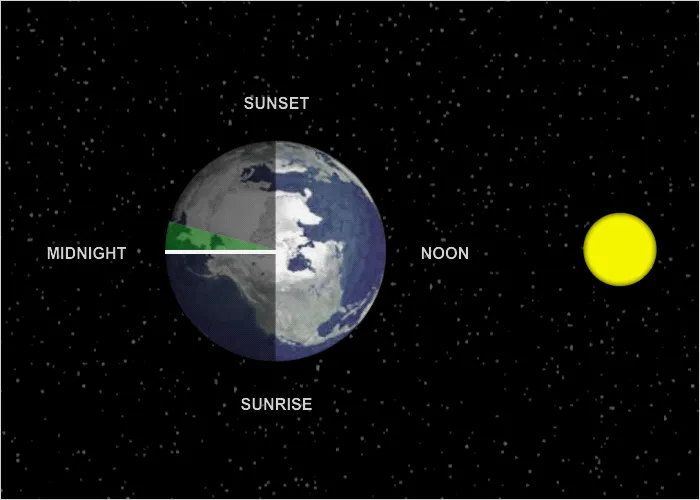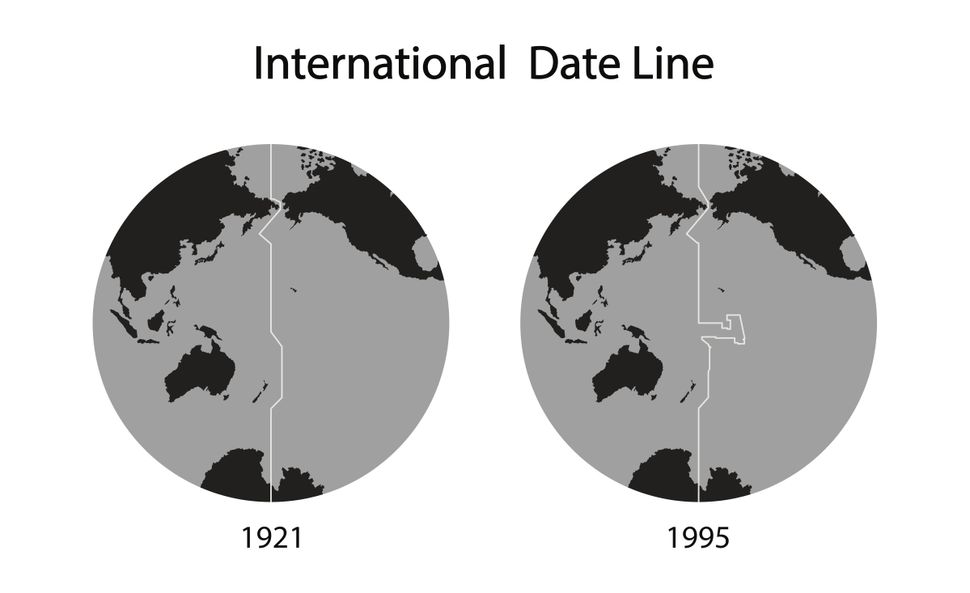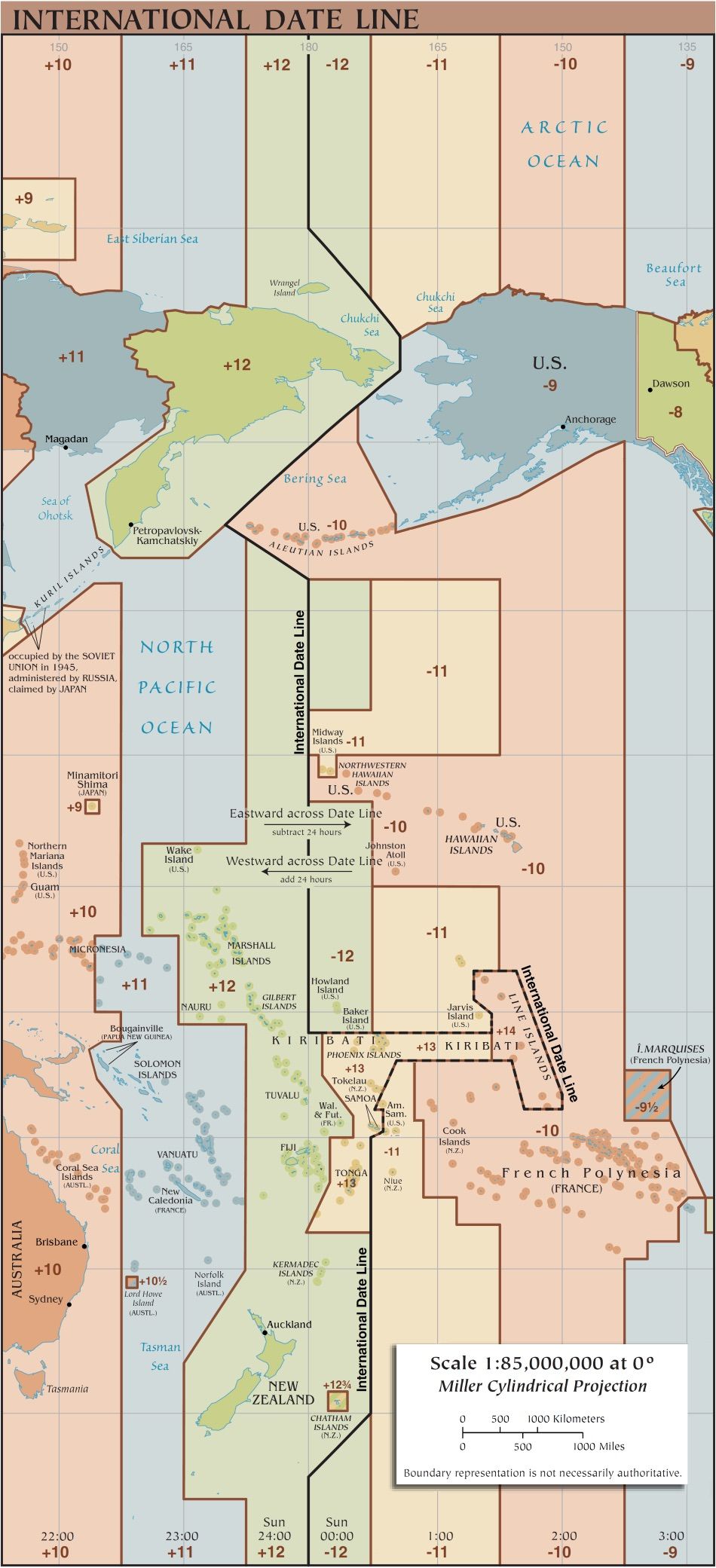The international date line, explained
국제 날짜 표시 줄,이 설명을 했다.
By Tom Garlinghouse about 10 hours ago
약 10시간전 톰 갈링하우스에 의한 글
The international date line is an imaginary line that runs north-south across the Pacific Ocean from the North Pole to the South Pole.
국제 날짜 표시선은 북극에서 남극까지
태평양을 남북으로 가로지르는 가상의
줄이다.

An illustration of the International Date Line. (Image credit: Dan Heim.)
국제 날짜 표시선의 그림.
(이미지 크레딧: 단 하임)
The international date line (IDL) is an imaginary line that runs along the Earth's surface from the North Pole to the South Pole in the middle of the Pacific Ocean. When you cross it, you either gain or lose a day depending on which way you are traveling. If you are traveling westward, you gain a day, and if you are traveling eastward, you lose a day.
국제 날짜 표시선(IDL)은 북극에서 태평양
한가운데 있는 남극까지 지구 표면을 따라
이어지는 상상의 줄이다.
길을 건너면 어느 길로 여행하느냐에 따라
하루를 얻거나 잃는다. 서쪽으로 여행하면
하루를 얻고 동쪽으로 여행하면 하루를 잃는다.
For example, if a traveler moves eastward across the Pacific Ocean from Wake Island to the Hawaiian Islands on June 25, they will jump backward to June 24 as soon as they cross the IDL. If, however, they are traveling in the opposite direction, they will arrive at Wake Island on June 26.
예를 들어, 만약 여행자가 6월 25일 웨이크
아일랜드에서 하와이 군도로 태평양을 가로
질러 동쪽으로 이동한다면, 그들은 IDL을
건너자마자 다시 6월 24일로 되돌아 점프해
갈 것이다.
하지만 만약 그들이 반대 방향으로 여행하고
있다면, 그들은 6월 26일에 웨이크 아일랜드
에 도착할 것이다.
Although the traveler seems to move backward or forward in time, there's no physics-defying magic going on here. The international date line is based on a rational, practical system of universal timekeeping that takes into account the movement of Earth around the sun.
비록 여행자가 시간을 거슬러서 혹은 앞으로
나아가는 것처럼 보이지만, 현재 물리학을
거스르는 마법이 벌어지는 것은 아니다.
국제적인 날짜 표시선은 태양 주위를 도는
지구의 움직임을 고려한 합리적이고 실용적인
보편적인 시간 측정 시스템에 기초한다.
Related: How can Samoa hop over the international date line?
관련내용:
사모아는 어떻게 국제선을 뛰어넘을 수 있을까?
Earth rotates counterclockwise (from west to east) on its axis as it travels around the sun. This means that different parts of the planet receive the sun's direct rays at different times, so when it is noon on one part of Earth — the period when the sun is at its highest in the sky — another part of the planet may be completely in shadow or experiencing sunrise or sunset. It also means that, theoretically at least, if you were somehow able to outrun Earth's rotation, which is a speed of roughly 1,000 mph (1,600 km/h), you could experience perpetual daylight and never see darkness.
지구는 태양 주위를 돌면서 축을 중심으로 시계
반대 방향(서에서 동)으로 회전한다.
이것은 행성의 다른 부분들이 다른 시간에 태양의
직사 광선을 받는다는 것을 의미하며,
그래서 지구의 한 부분에 정오가 되면 – 태양이
하늘에서 가장 높은 시기 –이 행성의 다른 부분은
완전히 그늘에 가려 있거나 일출이나 일몰을
경험하게 된다.
그것은 또한 이론적으로, 만약 여러분이 시속
약 1,600km/h의 속도인 지구의 자전 속도를
어떻게든 앞지를 수 있다면, 여러분은 영원한
일광을 경험할 수 있고 결코 어둠을 보지않아도
된다는 것을 의미한다.
But humans don't travel at such speeds (unless you are on the International Space Station), and when not traveling people generally stay in one place. So, to allow people to experience daylight hours in roughly the same amount — that is, to experience a normal day from sunrise to sunset — time zones are in use around the world.
그러나 인간은 국제우주정거장에 있지 않는 한
그러한 속도로 여행하지 않으며, 여행을 하지
않을 때는 일반적으로 한 곳에 머문다.
그래서, 사람들이 거의 같은 양으로 일광 시간
을 경험할 수 있도록 하기 위해, 즉 일출부터
일몰까지 평범한 날을 경험할 수 있는 시간대가
전세계에서 사용되고 있다.
The first system of time zones was proposed by Sir Sandford Fleming in 1876, according to an article in Globe and Mail, a Canadian news publication. Fleming was a Scottish engineer who helped design the Canadian railway system. He wanted to make the railroad more efficient and avoid any complications resulting from the different schedules set by the different train stations, which set the time according to their local astronomical conditions, according to Encyclopedia Britannica. Accordingly, he proposed a system of 24 standard time zones that would span the circumference of the Earth. Within each time zone, all clocks would be set to an average time that best represented where the sun was located in the sky. The practicality of his system soon caught on, so that by 1900 most of the industrialized nations of the world had adopted it.
캐나다 뉴스 간행물인 Globe and Mail의 기사에
따르면, 표준 시간대의 첫 번째 제도는 1876년
샌드포드 플레밍 경이 제안했다.
플레밍은 캐나다 철도 시스템 설계를 도왔던
스코틀랜드 엔지니어였다.
브리태니커 백과사전에 따르면, 그는 철도를 보다
효율적으로 만들고 여러 기차역에 의해 정해진
다른 일정으로 인한 문제를 피하고 싶었다.
따라서, 그는 지구의 둘레를 가로지르는 24개의
표준 시간대로 구성된 시스템을 제안했다.
각 시간대 내에서, 모든 시계는 태양이 하늘에
위치한 곳을 가장 잘 나타내는 평균 시간으로
설정될 것이다.
그의 체제의 실용성은 곧 인기를 얻었고, 그래서
1900년까지 세계의 대부분의 선진국들이 그것을
채택했다.

People walking beneath clocks displaying global time zones in the Warsaw Stock Exchange building in Warsaw, Poland. (Image credit: Getty Images/Bloomberg)
폴란드 바르샤바의 바르샤바 증권거래소
건물에서 시계 아래를 걷는 사람들.
(이미지 크레딧: 게티 이미지/블룸버그)
Today, with a number of significant modifications, we still use the 24-time-zone system originally proposed by Fleming. The logic of dividing Earth into 24 zones is derived from the fact that the planet is a sphere, and like any sphere it can be divided into 360 equal sections, or 360 degrees. Each time zone is measured as 15 degrees wide, and 360 divided by 15 is 24.
오늘날, 많은 중대한 수정이 있지만, 우리는
여전히 플레밍에 의해 원래 제안되었던
24시간대를 사용한다.
지구를 24개의 구역으로 나누는 논리는
행성이 구이고, 다른 구처럼 360도로 같은
구역, 즉, 360도로 분할할 수 있다는 사실
에서 유추된다.
각 시간대는 폭이 15도로 측정되고 360을
15로 나눈 값은 24가 된다.
All of these zones are numbered consecutively eastward from what is called the prime meridian, which is a line of longitude that runs directly through the British Royal Observatory in Greenwich, in the United Kingdom. The prime meridian was established in 1851 at a time when the U.K. was one of the most powerful and technologically advanced nations on Earth. With a powerful navy, the British were well advanced in navigation and timekeeping and were using the most sophisticated devices available to reckon global position and time. The prime meridian, at 0 degrees longitude, is the point from which all other measurements of longitude are taken. The prime meridian is also where the system of 24-hour timekeeping that is called Greenwich Mean Time (GMT) originated.
이 모든 지역은 영국 그리니치의 영국 왕립
천문대를 바로 관통하는 경도 선인 프라임
자오선에서 동쪽으로 연속적으로 번호가
매겨진다.
원시 자오선은 영국이 지구상에서 가장
강력하고 기술적으로 발달한 국가 중
하나였던 1851년에 세워졌다.
강력한 해군을 가진 영국은 항해와 시간
계측에 있어서 매우 발달했고 세계 위치
와 시간을 계산하기 위해 이용할 수 있는
가장 정교한 장치를 사용하고 있었다.
경도 0도의 주 자오선은 경도의 다른
모든 측정이 이루어지는 지점이다.
원 자오선은 또한 그리니치 표준시라고
불리는 24시간 계시 기록 시스템이
시작된 곳이기도 하다.
As you go east from the prime meridian, the time zones increase consecutively by one hour, or conversely, decrease consecutively by one hour as you go west. But Earth, of course, does not go on indefinitely; eventually, a point is reached when you have to start over — or jump backward or forward in time depending on your direction of travel.
본초 자오선에서 동쪽으로 가면 표준 시간대가
1시간씩 연속 증가하거나 서쪽으로 가면 1시간씩
연속 감소한다.
하지만 지구는 계속되는게 아니고 유한하다.
결국, 여러분이 다시 시작해야 할 때 어떤 점에
이르게 되며---혹은 여행방향에 따라 시간적으로
뒤나 앞으로 점프해야 할 시점에 도달하게 된다.
WHAT HAPPENS WHEN YOU CROSS THE INTERNATIONAL DATE LINE?
국제 날짜 선을 넘으면 어떻게 되나?
Here's an example of how time zones and the international date line works.
다음은 표준 시간대와 국제 날짜 표시 막대의 작동
방식을 보여 주는 예다.
London, U.K. is eight time zones away from San Francisco, California. Going eastward from San Francisco to London, you move ahead eight time zones, which really means you skip forward eight hours. So, when the time in San Francisco is 1 p.m, the time in London is 9:00 p.m. on the same day.
영국 런던은 캘리포니아 주 샌프란시스코에서 8개의
표준 시간대로 떨어져 있다.
샌프란시스코에서 런던으로 동쪽으로 가면 8개의
표준 시간대를 앞당겨 8시간을 건너뛰게 된다.
그래서 샌프란시스코의 시간이 오후 1시일 때,
런던의 시간은 같은 날 오후 9시이다.
However, if you were to move eight time zones in the opposite direction from San Francisco at 1 p.m. — that is, west across the Pacific Ocean to the Siberian city of Yakutsk, for example, things get complicated. It's not simply a matter of subtracting eight hours from the San Francisco time. You start by subtracting an hour for each time zone moving west, making it to 9:00 a.m., but at that point you'll hit the IDL, where everything changes. Now you have to add a full 24 hours to your calculations and jump a full day ahead, making it 9 a.m. the next day.
하지만 오후 1시에 샌프란시스코에서 반대 방향
으로 8개의 시간대를 이동한다면, 예를 들어,
태평양을 가로질러 서쪽으로 시베리아 도시
야쿠츠크로 가는 것은 복잡해진다.
그것은 단순히 샌프란시스코 시간에서 8시간을
빼는 문제가 아니다.
서쪽으로 이동하는 각 표준 시간대에 대해 한
시간을 빼서 오전 9시에 도착하지만,
그러면 IDL에 도달하여 모든 것이 변경된다.
이제 계산에 24시간을 더해야 하고 하루 종일
을 점프해간 다음 날 오전 9시가 된다.
But you're not done yet. Because all the time calculations are taken from Greenwich, you must subtract four more hours from that time because Yakutsk sits four time zones west of the IDL. So, when the time in San Francisco is 1:00 p.m. on Wednesday, it is 5:00 a.m. on Thursday in Yakutsk.
하지만, 아직 끝난게 아니다. 모든 시간 계산은
그리니치로부터 취해지기 때문에, 야쿠츠크는 IDL
서쪽 4개의 시간대에 있기 때문에, 여러분은
4시간을 더 빼야 한다.
따라서 샌프란시스코의 시간이 수요일 오후
1시일 때 야쿠츠크에서는 목요일 오전 5시이다.

Depending on which direction you're going when you cross the international date line, you'll either jump forward or backward a day. (Image credit: Getty Images/ Yaorusheng)
국제 날짜 선을 넘을 때 어느 방향으로 가느냐에
따라 앞으로 또는 뒤로 하루를 점프할 수 있다.
(이미지 크레딧: 게티 이미지/야오성)
HOW THE IDL BEGAN
IDL에서 시작되는 방식
The IDL was established in 1884 during the International Meridian Conference held in Washington, D.C., according to Post Card History. President Chester A. Arthur convened the conference, which included representatives of 26 nations. The president, like other world leaders, saw the necessity of establishing standards for an international agreement on time and longitude. By the end of the 19th century, as global commerce progressed, communication technologies grew more sophisticated and nations grew increasingly interdependent, it was imperative that all clocks be set to a world standard.
포스트 카드 역사에 따르면 IDL은 1884년 워싱턴에서
열린 국제 자오선 회의 동안에 설립되었다.
체스터 A 대통령 아서는 회의를 소집했으며, 이 것은
26개국의 대표들을 포함하고 있었다.
대통령은 다른 세계 지도자들과 마찬가지로 시간과 경도
에 관한 국제 협약의 기준을 제정할 필요성을 느꼈다.
19세기 말 무렵, 세계 무역이 발전하고, 통신 기술이 더욱
정교해지고, 국가들이 상호의존적이 되면서, 모든 시계
를 세계 표준으로 맞추는 것이 필수적이었다.
With this in mind, the point of the conference, as summed up in the Protocols of the Proceedings, was "for the purpose of fixing upon a meridian proper to be employed as a common zero of longitude and standard of time-reckoning throughout the globe."
이것을 염두에 두고, 회의의 요점은, 의사 진행 규약에
요약된 바와 같이, "지구 전체에서 경도의 공통 영점
이자 시간 측정의 표준으로 사용되는 적절한 자오선을
정하기 위한 목적"이었다.
The conference resulted in the recognition of the prime meridian in Greenwich, which had already been in use for several decades, as the world's single "initial meridian." Although other prime meridians were in existence at the time, such as ones in Rome, Paris, Jerusalem, St. Petersburg and Oslo, for example, the Greenwich meridian was adopted primarily because over two-thirds of ships already used it for zero longitude.
이 회의는 이미 수십 년 동안 사용되었던 그리니치의
원초 자오선을 세계에서 단 하나의 "초기 자오선"으로
인정하는 결과를 낳았다.
비록 로마, 파리, 예루살렘, 상트페테르부르크, 오슬로
와 같은 다른 주요 경도들이 그 당시에 존재했지만,
그리니치 자오선은 주로 선박의 3분의 2 이상이 그것을
이미 경도 0으로 사용했기 때문에 채택되었다.
In all, seven resolutions were passed at the end of the conference. These ranged from adopting a universal solar day (beginning at midnight in Greenwich and counted on a 24-hour clock) to the proposal that all nautical and astronomical days everywhere would begin at 12:00 a.m.
총 7개의 결의안이 회의 마지막에 통과되었다.
이것들은 보편적인 태양일(그린니치에서 자정에 시작되며
정각 24시에 카운트되는)을 채택하는 것에서부터 모든
해리와 천문학적인 날이 오전 12시에 시작한다는 제안에
이르기까지 다양했다.
The IDL was established as a result of the conference's Third Resolution, which stated: "That from this meridian longitude shall be counted in two directions up to 180 degrees, east longitude being plus and west longitude minus."
IDL은 "이 자오선 경도로부터는 최대 180도로, 동쪽 경도는
플러스이고 서쪽 경도는 마이너스인 두 방향으로 계수되어야
한다," 라고 명시된 회의의 제3차결의안이 결론안으로 설정되었다.
The logic behind this is that on a discrete sphere, the day and date have to be separated at two locations — you can't split a sphere into two parts with a single "cut" on one side. You need a starting and an ending point.
이면의 논리로 별개의 구면에서는 날과 날짜가 두 위치
에서 분리되어야 한다는 것인데--한쪽 면의 "컷" 하나로
구면을 두 부분으로의 분할은 불가능하며, 여러분은 시작점과
끝점을 필요로 한다.
None of the resolutions, however, were binding. It was up to each country to enforce these proposals. Even today, for example, the IDL is not a matter of international law, nor is it enforced by the dictates of an international governing board. It is accepted by all nations and has been adopted because it is crucial for global interconnectivity, instantaneous communication, time measurement and consistent international databases.
그러나 어떤 결의도 구속력이 없었다. 이 제안들을 시행하는 것은
각 나라에 달려있다. 예를 들어 오늘날에도 IDL은 국제법의 문제가
아니며, 국제 관리 위원회의 명령에 의해 시행되지도 않는다.
모든 국가가 이를 수용하고 채택한 이유는 글로벌 상호 연결, 즉각
적인 통신, 시간 측정 및 일관된 국제 데이터베이스에 중요하기
때문이다.
WHY IS THE INTERNATIONAL DATE LINE NOT STRAIGHT?
국제 날짜 표시줄이 직선적이지 않은 이유는 무엇인가?
An excellent way of visualizing the IDL is to think of it in terms similar to a line of longitude. In fact, it roughly follows the 180-degree meridian, which is located halfway round the world from the prime meridian. But the IDL, unlike a meridian line, does not run in a straight path. Since its inception, the IDL has undergone several major deviations, and it now swerves, zig-zags and jogs in a seemingly arbitrary pattern around prominent landmasses and certain Pacific islands. Most of these deviations are the result of practical considerations, such as to avoid splitting a country into two time zones, or for political and economic reasons.
IDL을 시각화하는 훌륭한 방법은 그것을 경도선과 비슷한 용어로
생각하는 것이다.
사실, 이것은 대략 원 자오선에서 지구 반 바퀴에 위치한 자오선을
따라간다.
하지만 IDL은 자오선과 달리 직선 주로를 달리지 않는다. IDL은
처음 시작된 이후로 몇 가지 중대한 편차를 겪었으며, 이제는
거대한 땅덩어리와 특정 태평양 섬 주변에서 제멋대로의 패턴
으로 방향을 틀고 지그재그로 움직이고 갑작스런 방향전환을 한다.
이러한 일탈의 대부분은 한 나라를 두 개의 시간대로 나누는 것
을 피하는 것과 같은 실질적인 고려의 결과이거나 정치적, 경제적
이유로 인한 것이다.
The IDL runs south from the North Pole, following the 180-degree meridian until it swerves east to pass through the Bering Strait, keeping Big Diomede Island, a part of Russia, west of the IDL, and Little Diomede Island, which is part of the United States, to the east. Although the islands are only separated by the narrowest of margins — just 2 miles (3.2 kilometers) — they experience different days, with Big Diomede Island always one day ahead of Little Diomede Island. The IDL then jogs back west to skirt around the United States’ Aleutian Islands, keeping Russia and Alaska on opposite sides.
IDL은 북극에서 남쪽으로 진행되며 180도 자오선을 따라 동쪽
으로 방향을 틀며 베링해협을 통과해 러시아의 일부인 빅디오
메데 섬과 미국의 일부인 리틀디오메데 섬을 동쪽으로 유지한다.
비록 이 섬들은 가장 좁은 여백 (3.2 킬로미터)으로만 떨어져 있지만,
빅 다이오메데 섬은 항상 리틀 다이오메데 섬보다 하루 앞서서 다른
날들을 경험한다. 그리고 나서 IDL은 러시아와 알래스카를 반대편
에 두면서 미국의 알류샨 열도를 돌기 위해 뒤로 서쪽으로 갑작스런
방향전환을 한다.
International Date Line
국제 날짜 표시선

Simple map showing the location of the international date line in 1921 and 1995. (Image credit: Shutterstock/Nasky)
1921년과 1995년의 국제 날짜 표시 위치를 보여주는 간단한 지도.
(이미지 크레딧: 셔터스톡/나스키)
It then tracks back, following the 180-degree meridian south again for several thousand miles, passing west of the Hawaiian Islands and east of the independent nation of the Marshall Islands, until reaching the Pacific island nation of Kiribati. Here, the IDL makes a major deviation east to encompass the Kiribati and Line Islands, the latter of which is also known as the Teraina or Equatorial Islands. This deviation reaches nearly as far east as the 150-degree meridian and forms a very large and noticeable hammerhead-looking configuration.
그런 다음, 하와이 제도의 서쪽과 독립 국가 마셜 제도의 동쪽을 지나
태평양 섬나라 키리바시에 도달할 때까지 다시 남쪽으로 180도 자오선
을 따라 수천 마일에 걸쳐 되돌아간다.
여기서 IDL은 키리바시와 라인 군도를 포함하기 위해 동쪽으로 크게
일탈하고 있는데, 라인 군도는 데라이나 군도 또는 적도 군도로도
알려져 있다.
이 편차는 거의 먼동쪽 150도 자오선까지 도달하며 매우 크고 눈에
띄는 망치 머리 모양을 형성하고있다.
Kiribati, which received its independence from the United Kingdom in 1979, is a group of 33 mostly uninhabited islands and atolls that span a vast area encompassing no less than 1.9 million square miles (5 million square kilometers). Prior to the 1990s, the IDL bisected the island nation, throwing its western half a day ahead of its eastern half, according to the CIA's World Fact Book. This caused considerable political and economic hardships as the nation tried to conduct normal everyday business with one half of its nation a day ahead and the other a day behind. In 1995, Kiribati decided it had had enough of this arrangement, and seeking greater economic ties with Australia and New Zealand, extended the IDL eastward to encompass the nation's far-flung eastern islands, thus creating the odd configuration.
1979년 영국으로부터 독립한 키리바시는 500만 km(190만 제곱마일)
이상의 넓은 지역에 걸쳐 있는 대부분 무인도와 환초 33개 집단이다.
1990년대 이전에는 IDL이 이 섬나라를 이등분하여 서부 지역을 동부
반쪽보다 반나절 먼저 내던졌다고 CIA의 세계사실은 밝혔다.
이는 그 나라가 하루 앞서고 또 하루 뒤로 한 채 일상 업무를 정상적
으로 수행하려고 했기 때문에 상당한 정치적, 경제적 어려움을 야기
했다.
1995년, 키리바시는 이 협정이 충분하다고 판단했고, 호주 및 뉴질
랜드와 더 큰 경제적 유대를 모색하면서, IDL을 동쪽으로 확장하여
멀리 떨어진 동쪽에 위치한 섬들을 포함시켰고, 따라서 이상한 구성
을 만들었다.
Shifting the date line is a relatively easy matter, the BBC reported. It doesn’t require the agreement of other countries or the sanction of an international governing body. The country can decide for itself. It’s simply a matter of publicizing the event and informing the international community and map-makers.
날짜선 변경은 비교적 쉬운 문제라고 BBC는 보도했다.
그것은 다른 나라들의 동의나 국제 관리 기구의 제재를 필요로 하지
않는다.
그 나라는 스스로 결정할 수 있다.
그것은 단지 행사를 홍보하고 국제 사회와 지도 제작자들에게 알리는
문제이다.

Map of the international date line in the South Pacific.
(Image credit: Wikimedia/Jailbird, license: https://creativecommons.org/licenses/by-sa/3.0/deed.en)
남태평양의 국제 날짜 표시선 지도.
(이미지 크레딧: Wikimedia/Jailbird, 라이센스: https://creativecommons.org/licenses/by-sa/3.0/deed.en)
Leaving Kiribati, the IDL passes between Samoa and American Samoa, keeping the former west and the latter east of the IDL. It then swerves back sharply toward the 180-degree meridian, but does not follow the meridian's exact path. Instead, it stays parallel to the meridian, keeping to the east of the line so that Tonga, the Kermadec Islands and New Zealand are all east of the IDL.
키리바시를 떠나서, IDL은 사모아와 아메리칸사모아 사이를 통과하며,
IDL의 구 서부와 후자를 유지한다.
그리고 나서 그것은 180도 자오선 쪽으로 급격히 방향을 틀지만,
자오선의 정확한 경로를 따르지는 않는다.
대신에, 그것은 자오선과 평행하게 유지되고, 동쪽선을 유지하여 통가,
케르마덱 제도, 뉴질랜드가 모두 IDL의 동쪽에 있도록 한다.
South of New Zealand, in the vicinity of the Chatham Islands, which are part of New Zealand, the IDL jogs back and connects up again with the 180-degree meridian. It follows this path until reaching Antarctica, which has multiple time zones. The IDL is not drawn into Antarctica on most maps.
뉴질랜드 남쪽, 뉴질랜드의 일부인 채텀 제도 부근에서 IDL은 뒤로
갑작스런 방향 전환을 하다가 180도 자오선과 다시 연결된다.
그것은 여러 개의 시간대가 있는 남극대륙에 도달할 때까지 이 길을
따라간다.
IDL은 대부분의 지도에서 남극대륙으로 그려지지 않는다.
UNIVERSAL COORDINATED TIME
국제 표준시
Today, a method known as Universal Coordinated Time, abbreviated as UTC, has become the timekeeping standard. In essence, it is a more sophisticated version of GMT because it is still based on the zero degrees of latitude that passes through Greenwich but relies on atomic clocks. These devices, invented in the 1950s, are incredibly accurate and are based solely on Earth's rotation. The clocks take into account slight variations in the Earth's rotation rate that can cause timekeeping to vary.
오늘날 Universal Coordinated Time(국제 표준시), 약어로는UTC로
알려진 방법은 시간 측정 기준이 되었다.
본질적으로, GMT는 그리니치를 통과하지만 원자시계에 의존하는
위도 0도에 여전히 바탕을 두고 있기 때문에 더 정교한 버전이다.
1950년대에 발명된 이 장치들은 믿을 수 없을 정도로 정확하며
지구의 자전에만 바탕을 두고 있다.
이 시계들은 시간 측정의 변화를 일으킬 수 있는 지구의 회전율
에서 약간의 변화를 고려한다.
ADDITIONAL RESOURCES
추가 리소스
Further reading: "Plotting the Globe: Stories of Meridians, Parallels, and the International Date Line (Explorations in World Maritime History)" (Praeger, 2005) by Avraham Ariel and Nora Ariel Berger Read more about the International Meridian Conference. Don't feel like doing math? Here's a helpful time zone converter that will do it for you.
더 읽어볼 것: 에이브러햄 아리엘과 노라 아리엘 버거의 "지구를
구성하는 것: 메리디안 이야기, 평행선, 그리고 국제 날짜선 (세계
해양 역사의 탐험)" (Praeger, 2005)
국제 자오선 회합에 대해 자세히 읽어 보십시오.
수학을 하고 싶지 않나요? 여기에 도움이 되는 시간대 변환기가
있습니다.
This article has been updated from a previous version written by Dan Helm in 2018.
이 기사는 2018년 단 헬름이 작성한 이전 버전에서 업데이트되었다.
Originally published on Live Science.
라이브 사이언스에 원본으로 발간됨.

댓글 없음:
댓글 쓰기